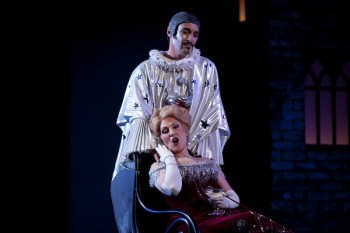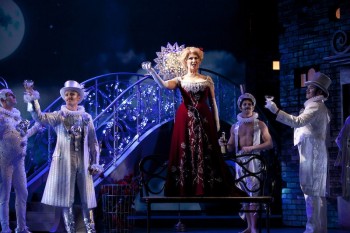Opera Australia’s Die tote Stadt, Sydney
Despite being composed almost 100 years ago, Die tote Stadt has never before been performed in Australia.

Despite being composed almost 100 years ago, Die tote Stadt has never before been performed in Australia. Composed by Academy Award winner Erich Wolfgang Korngold, when he was only 23 years old, the score has touches of Puccini and Strauss flowing through, and requires a mammoth orchestra.
The Australian premiere of this production has been sold largely on the basis that it requires an orchestra so large it cannot fit in the Opera Theatre pit. The orchestra instead plays from the Opera House’s studio and the sound is relayed back into the theatre. It’s a first for the company and a fairly innovative concept, but what’s really surprising is how little you actually notice it. The sound design is so crisp that if you hadn’t been told, and were sitting a long way from the stage, you might not even realise the orchestra was playing from a different room. It’s just as good, if not better than the real thing.
It’s that sound that allows you to be swept up in the lush brilliance of Erich Korngold’s score, without ever thinking about the technical side of the show.
Die tote Stadt tells the story of Paul, a man in despair after losing his wife. He spends his time alone in a room devoted to the memory of his wife, complete with her portrait, her belongings and the braid of hair she left as she died. One night, he meets Marietta, who looks exactly like his deceased lover. He struggles to find a balance between expressing his feelings for Marietta and holding onto his love for his ex-wife.

Director Bruce Beresford has created a production that blurs the line between dream and reality, exploring the crushing grief that Paul can’t shake. Beresford explores the difficult relationship between Marietta and Paul in a very intimate way, but has also produced a spectacular procession in grand fashion. There’s some pacing and action missing in the production, but it adds to the dwelling, contemplative nature of the story.
The set, by John Stoddart perfectly captures a delicate balance between the dead and the living. There’s an almost intoxicating stuffiness in his design of the interior of Paul’s house that is smattered wall to floor in cloudy blues and stars. Nigel Levings’ lighting adds to the dreamlike feel of the stage, with characters constantly wandering in and out of shadow and light.
After a more-than-shakey start, Stefan Vinke turns in a memorable performance as Paul. Paul is a ridiculously challenging role, requiring the tenor to sing more B flats than you can poke a stick at, but after some initial struggles, Vinke proves himself to have a voice that fills the theatre beautifully and conveys Paul’s grief and desperation.
Cheryl Barker’s Marietta is seductive and energetic. Her confidence in what is a difficult role shows exactly why she’s one of Australia’s leading sopranos. She easily matches Vinke in vocal power.
Jose Carbo’s aria as Fritz is beautifully sung. Carbo is one of the most underrated operatic singers in Australia, and his brief appearance in the opera is a definite musical highlight.
But the star of the show is clearly the music. The Australian Opera and Ballet Orchestra capture every nuance and the expression of Korngold’s score perfectly under Christian Badea’s baton.
Die tote Stadt is a technical triumph. But the reason why it is triumphant is the way technology has been seamlessly integrated into a 1920 opera. Opera Australia should be commended for pushing the boundaries and ultimately enriching a beautiful and intriguing opera.
Running time: approx three hours (including two twenty-minute intervals)

I don`t care what they about it, the orchestra should be in the SAME space as the opera, NOT opera in one space and the orchestra in another room, the people that run the opera house, should spend MORE MONEY to enlarge the orchestra pit and stage. The Royal Covent Garden in London was closed for nearly 2 years and they have refurbished, extended and updated everything, now it is the pride of London. Sydney Opera House, beautiful from the outside, but crappy inside.
I’m with Ronald on this one. Canned music is canned music. Orchestra pits are in Opera Houses for one good reason – live music to complement and enhance the singing and narrative. To do what has been done with this production is an admission of defeat. The Opera Theatre contained within the Sydney Opera House is not suitable for anything other than chamber opera.
Sydney desperately needs a world class opera house complex. The SOH is deservedly one of the marvels of modern architecture on the outside, but this overhyped production reveals how inadequate it is within. A great tragedy.
That is why, the Australian Opera will have the FULL WAGNER RING CICLE in Melbourne (2013) because the stage at the Melbourne opera theatre is large, deep, high and wide, perfect for any grand scale opera productions and at the moment they are extending the orchestra pit from 80 to 110 musicians.